Simple Summary
This systematic review and meta-analysis evaluates small intestinal gastrointestinal stromal tumor (SI-GIST) prevalence patterns in neurofibromatosis type I (NF-1) patients, offering the first focused assessment of this specific anatomical subset. By isolating small intestinal cases, this work provides precise epidemiological data comparing NF-1-associated and sporadic GIST frequencies, while analyzing multifocal versus solitary tumor distributions. The study addresses key knowledge gaps regarding SI-GIST prevalence in NF-1, clinical presentation patterns, and comparative population-level risks, aiming to establish clearer diagnostic benchmarks and characterize the epidemiological burden of NF-1-associated GISTs. Insights from this study could improve clinical surveillance through evidence-based risk stratification, while the methodological focus on small intestinal tumors ensures biologically relevant comparisons. The results inform both NF-1 management guidelines and fundamental research into GIST development mechanisms, particularly regarding NF-1-related tumorigenesis pathways. This work bridges clinical epidemiology and molecular oncology by contextualizing observed prevalence patterns within current pathogenic models of GIST formation.
Abstract
Background/Objectives: The present investigation quantifies the striking predisposition for small intestinal GISTs in NF-1 patients, examining both multifocal and solitary tumor patterns while establishing critical epidemiological comparisons with the general population. By elucidating these distinct clinical and biological profiles, the study aims to transform the understanding of NF1-associated tumorigenesis and optimize patient surveillance strategies. Methods: This systematic review and meta-analysis was conducted in strict accordance with PRISMA guidelines, the gold-standard framework for minimizing bias and maximizing reproducibility in evidence synthesis. Prospectively registered in PROSPERO, the study employed a PICO framework to evaluate interventions, outcomes, and comparisons. Results: This systematic review and meta-analysis reveals a profound oncogenic propensity for small intestinal GISTs in NF-1 patients, demonstrating markedly increased prevalence relative to population baselines. The tumors display characteristic presentation and histological profiles, with a distribution of 54% multifocal lesions, 41% solitary SI-GIST, and 5% solitary duodenal GIST cases, demonstrating the diverse clinical manifestations of NF-1-associated tumors. These compelling findings not only redefine the epidemiological landscape of NF1-associated malignancies but also underscore extraordinary disease susceptibility, far surpassing previous estimates and sporadic occurrence rates in the general population. Conclusions: The distinct clinical patterns and high frequency of these tumors among NF-1 patients provide important insights into GIST development while underscoring the need for heightened clinical suspicion, particularly in patients manifesting gastrointestinal hemorrhage. These findings highlight the unique challenges in managing these cases—including diagnostic limitations and therapeutic constraints—underscoring the imperative for multidisciplinary therapeutic frameworks for detection, monitoring and treatment in this high-risk population.
1. Introduction
Gastrointestinal stromal tumors (GISTs) are a distinct category of tumors originating from the interstitial cells of Cajal (ICCs) [1]. The pathogenic mechanism behind their development is complex. At the molecular epicenter, gain-of-function mutations in KIT (proto-oncogene, receptor tyrosine kinase) or PDGFRA (Platelet-Derived Growth Factor Receptor Alpha) ignite constitutive tyrosine kinase activation, propelling interstitial cells of Cajal toward neoplastic transformation through unchecked proliferative signaling cascades. NF-1-associated GISTs orchestrate their tumorigenic symphony via neurofibromin loss, unleashing RAS/MAPK (Mitogen-Activated Protein Kinase) pathway hyperactivity while conspicuously lacking the canonical KIT/PDGFRA driver mutations. The succinate dehydrogenase (SDH)-deficient variant emerges as a distinct epigenetic maverick, where SDH complex aberrations induce a CpG island methylator phenotype (CIMP), rewriting the transcriptional landscape of transformed precursors [2,3]. A major breakthrough in understanding the molecular mechanisms involved in their formation was made by Hirota et al. in 1998 [4]. In this study, it was found that the receptor for the stem cell growth factor (KIT) is expressed in the vast majority of GISTs [4]. Wild-type renegades—devoid of KIT/PDGFRA/RAS/SDH lesions—chart alternative oncogenic routes through BRAF (B-Raf proto-oncogene, serine/threonine protein kinase) mutations or noncoding RNA networks that hijack cellular homeostasis. This molecular taxonomy directly dictates therapeutic vulnerability: while KIT-mutated GISTs bow to tyrosine kinase inhibition, their SDH-deficient and NF-1-driven counterparts mount intrinsic resistance, demanding alternative therapeutic strategies [2,3]. Overall, 85% of GISTs are caused by mutations in the KIT/PDGFRA genes, while the remaining 15% result from other pathogenic mechanisms unrelated to KIT [5]. Only 1–2% of all GIST cases occur in patients carrying a mutation in the NF-1 gene, which is responsible for neurofibromatosis [6,7]. This subset of patients does not present mutations in the KIT gene and falls under the 15% of cases mentioned above [5]. This category includes cases with a deficiency in the enzyme SDH, cases with BRAF gene mutations, and, of course, cases of patients with NF-1 gene mutations and dysfunction of the corresponding protein neurofibromin, as previously mentioned [8].
Neurofibromatosis type 1 is a genetic disorder with a prevalence of 1 in 3000–3500 individuals [9,10]. It was first described in great detail by Friedrich Daniel von Recklinghausen in 1882 [11], and in many references, it bears his name [12]. It is inherited in an autosomal dominant manner [13,14]. Signs and symptoms are often present at birth, but they usually manifest before the age of 10 [13,14]. The clinical presentation of affected individuals includes café-au-lait spots, neurofibromas, Lisch nodules, scoliosis, small tumors in the iris, and distant tumors throughout the body, such as pheochromocytomas or GISTs [13,14]. Learning disabilities are also observed in young patients [15]. Diagnosis is based on clinical criteria [13,14]. These individuals often undergo surgical procedures to remove tumors from various parts of the body [16,17]. However, in most cases, patients with NF-1 experience moderate symptoms and lead a normal and productive life [18,19,20,21]. With advances in managing these patients, life expectancy has significantly increased, and in some cases, it can approach that of the general population [22,23]. This, combined with molecular testing and improved patient monitoring, has led to an increasing number of recorded cases of neurofibromatosis in the general population. Thus, the condition appears to be much more common than previously believed [13,24,25].
The dysfunction of the neurofibromin protein negatively regulates the activity of the Ras/MAPK (Mitogen-Activated Protein Kinase) molecular pathway [26,27]. This indirectly leads to the growth signaling of KIT/PDGFRA mRNA, resulting in the formation of different types of tumors each time [28,29]. GISTs represent a histological tumor category that occurs with increased frequency in patients with NF-1 and, more specifically, is observed in the small intestine [6,7,30,31,32,33]. In most cases, they are multifocal [32,33]. The clinical presentation of gastrointestinal GISTs is similar to that of any other gastrointestinal tumor [34]. They commonly manifest with bleeding, obstruction, and, less frequently, perforation. However, they are rarely the first manifestation of NF-1 [34,35,36]. A major challenge for clinicians is the bleeding caused by multifocal small intestine GISTs [36,37,38,39,40,41]. The particular difficulty lies in the localization study of the exact bleeding site, which may even necessitate intraoperative endoscopy when imaging modalities fail [42,43,44,45,46,47].
A vast number of studies attempt to examine the increased frequency of GISTs in NF-1 patients at both epidemiological and molecular levels [6,7,32,33]. Since the number of cases is small and research spans a long period, comparative analysis with the general population (i.e., sporadic GIST cases) is usually not performed. Instead, emphasis is placed on the increased prevalence of GISTs in NF-1 patients and the pathogenic mechanism of GISTs [6,7,32,33]. Additionally, studies document the various gastrointestinal sites where GISTs occur without focusing particularly on the most common site, which is the small intestine in NF-1 patients [6,7,32,33].
In the present study, we conduct a systematic review of the literature. The prevalence of small intestinal GISTs in NF-1 patients is analyzed. A statistical correlation is drawn between multifocal and solitary small intestinal GIST cases. Additionally, the prevalence of sporadic small intestinal GISTs in the general population is examined. Our findings indicate that the occurrence of small intestinal GISTs in NF-1 patients is significantly higher compared to sporadic small intestinal GISTs. As far as we could determine, this is the first systematic review with a meta-analysis focusing specifically on small intestinal GISTs. We considered it appropriate to isolate cases affecting a specific part of the gastrointestinal tract, the small intestine in this case, to make the systematic review more focused. Such an approach has greater clinical relevance and offers a more epidemiologically robust analysis, as the tumor’s pathogenesis differs. If research specifically targets the small intestine, the tendency of NF-1 patients to develop GISTs appears to be much higher than previously believed. This finding is analyzed in detail both at the epidemiological and pathogenic levels.
2. Materials and Methods
2.1. Study Design and Inclusion/Exclusion Criteria
This systematic review and corresponding meta-analysis were conducted following the PRISMA (Preferred Reporting Items for Systematic reviews and Meta-Analyses) algorithm, based on guidelines for systematic reviews (Figure 1) [48]. The study was prospectively registered in the PROSPERO database and received the ID number CRD420251002384. The entire study was based on the following PICO research question:
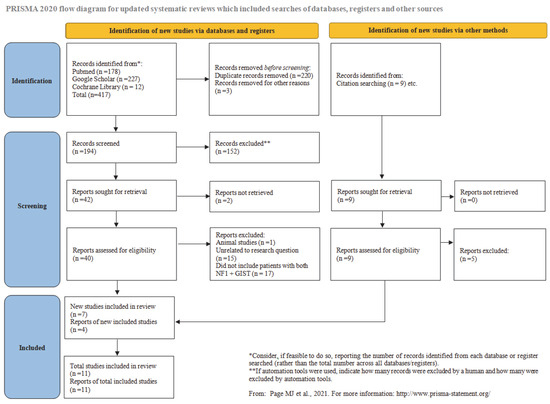
Figure 1.
PRISMA flow diagram [48].
- Patients: Patients with SI (small intestinal) GISTs.
- Intervention: NF-1 gene
- Comparison groups: Multifocal SI-GIST NF-1 vs. sporadic/solitary SI-GIST NF-1.
- Outcomes: Prevalence of multifocal SI-GIST NF-1 vs. prevalence of sporadic/solitary SI-GIST NF-1 (long period of research).
Prevalence was chosen as the primary metric for comparing the two population groups since incidence data are not accurately reported in the literature, particularly for GISTs in NF-1 patients. The two population groups differ in life expectancy and the age range in which GISTs appear. Additionally, the studies were conducted over an extended period, making it difficult to precisely calculate the overall incidence between the two groups. Prevalence serves as an indirect indicator of the tendency to develop GISTs in the two populations. All studies included in this systematic review were retrospective, as the number of NF-1 patients with GISTs is very small. For this reason, the studies were also non-randomized. The inclusion criteria required that all studies had a large patient cohort with clearly defined quantitative data for both NF-1 and GISTs in the small intestine. The exclusion criteria were as follows:
- Non-relevant articles.
- Studies that did not report quantitative data for NF-1 and GISTs.
- Animal studies.
- Case reports or systematic reviews based on case reports.
- Letters to the editor.
- Irrelevant systematic reviews.
- Studies with only abstracts available or those for which the full article could not be accessed.
2.2. Literature Search Strategy
Eligible studies included in the meta-analysis were retrieved using three search engines: PubMed, Scopus, and ResearchGate. The search algorithm used was as follows: ((NF-1) OR (GIST)) AND (GIST on NF-1 patients) OR (complications NF-1) OR (prevalence NF-1) OR (prevalence GIST) OR (GIST general population). No specific filters were applied in our search. Two scholars worked independently to choose the studies. A consensus was reached with a third researcher to settle any disputes. Additionally, a thorough examination of the reference lists of the selected studies was performed to identify potentially relevant studies using the snowball effect methodology [49].
2.3. Data Extraction and Assessment of the Risk of Bias
Two independent researchers collected the data and recorded it in two separate Microsoft Excel® spreadsheets (Table 1 and Table 2). Both researchers analyzed GIST cases in NF-1 patients as well as GIST cases in the general population. Only small intestinal GISTs were recorded. Regarding GISTs in NF-1 patients, a detailed breakdown was performed, categorizing tumors as multifocal, solitary, or duodenal GISTs. Particular emphasis was placed not only on the tumor localization but also on the clinicopathological characteristics, such as the interstitial cell of Cajal (ICC) hyperplasia. Since all studies included in this systematic review were non-randomized, the ROBINS-E (Risk of Bias in Non-Randomized Studies of Exposures) tool was used to evaluate the risk of bias [50,51]. Articles were classified into four categories; low risk of bias, moderate risk of bias, high risk of bias, and very high risk of bias. Additionally, the overall risk of bias was assessed using the ROBINS-E algorithm, which is widely applied in epidemiological studies [50,51]. A panel was assembled to assess the bias-related questions (Figure 2), and a percentage analysis of these assessments is presented in Figure 3. The included studies represent a large and diverse patient population, covering various NF-1 research centers worldwide and different time periods. The likelihood of case duplication or overlap was considered highly improbable [50,51].

Table 1.
Spreadsheet generated by the first researcher.

Table 2.
Spreadsheet generated by the second researcher; n: number, N/R: not reported.
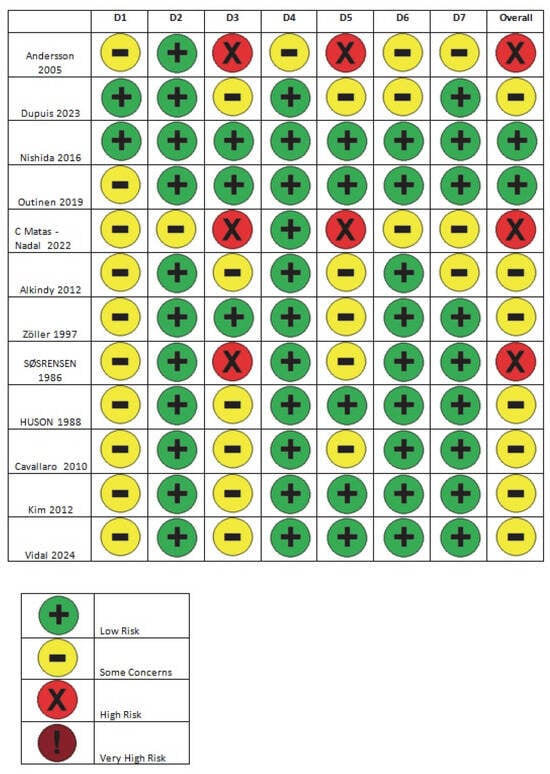
Figure 2.
ROBINS-E bias evaluation panel [52,53,54,55,56,57,58,59,60,61,62,63].
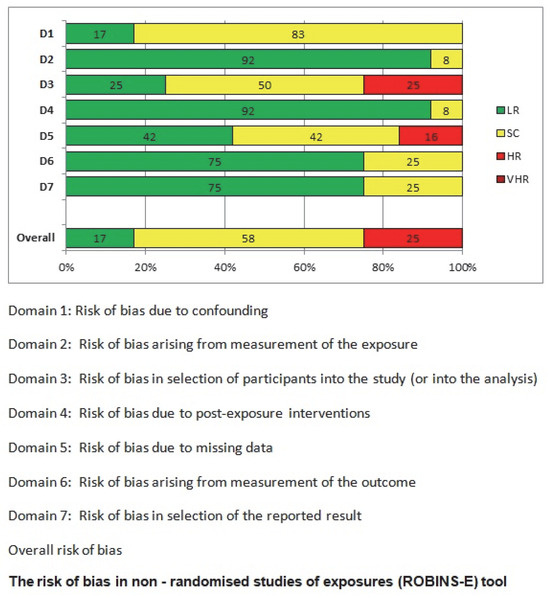
Figure 3.
Percentage analysis of the bias-related questions’ assessments.
2.4. Data Pooling
Data were recorded in Microsoft Excel® tables, using absolute numbers as reported in each study. The two independent researchers responsible for data collection cross-checked the final studies and initially compiled their datasets separately. In rare instances of discrepancies, a third researcher participated in the process to ensure data accuracy and finalize the records. A consensus was always reached within the research team before a unified dataset was produced. This approach was applied to both NF-1-associated GIST data and sporadic GIST data in the general population.
2.5. Meta-Analysis
The meta-analysis of GIST prevalence rates was conducted using Jamovi® software (Version: 2.3.16.0), which provided pooled estimates and generated forest plots [91]. All estimates were based on the frequency data reported in the primary analyses of the included studies. For the analysis, a random-effects model was employed using the inverse variance method. The level of statistical significance was set at 0.05 in all cases. Heterogeneity among studies was assessed using Cochran’s Q statistic and quantified using the I2 statistic [92]. Studies were considered to have significant heterogeneity if p < 0.1 or I2 > 50%, and a funnel plot was used to assess publication bias [91,92]. Moreover, a subgroup analysis was conducted, particularly focusing on NF-1 patient data (Figure 4).
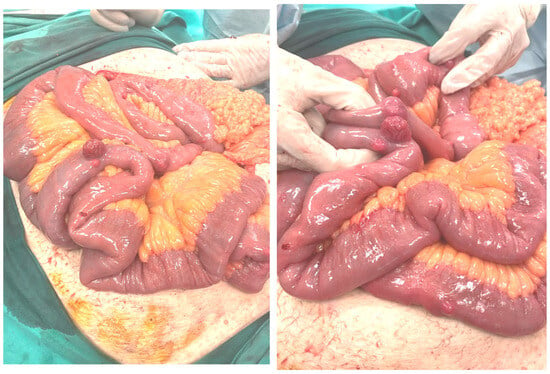
Figure 4.
Multifocal small intestinal GIST resected during emergency surgery for acute intraluminal bleeding in an NF-1 patient (3rd Surgical Department, AHEPA University Hospital, School of Medicine, Aristotle University of Thessaloniki archive).
3. Results
3.1. Data Analysis
3.1.1. Dataset 1: GISTs and NF-1 in the Total Number of Patients with NF-1
A total of 10 studies were included in the analysis, comprising 1386 recorded cases of NF-1 patients [53,54,55,56,57,58,60,61,62,63]. The analysis for the pooled estimate of the proportion of small intestinal GIST cases among the total NF-1 patient population per study was based on random-effects models and the inverse variance method after logarithmic transformation. The pooled proportion estimate is 0.03 with a 95% confidence interval (0.02–0.05). The values for each study are presented in Table 3 and are graphically represented in the forest plot (Figure 5), along with the pooled estimate and heterogeneity indices. The heterogeneity test among studies presented in Figure 6 showed an I2 value of 54%, which is statistically significant with p = 0.02. The assessment for publication bias using the funnel plot indicates symmetry (Figure 6), supporting the conclusion that there is no significant impact from the selection of the included studies on the results.

Table 3.
Source studies contributing to dataset 1.
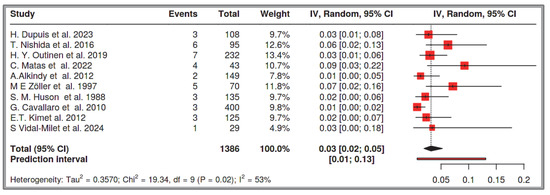
Figure 5.
Dataset 1 forest plot [53,54,55,56,57,58,60,61,62,63].
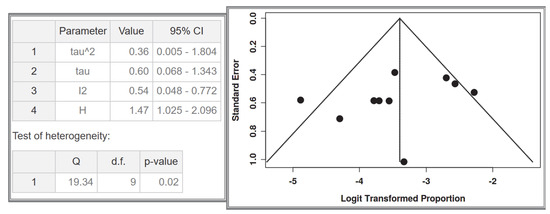
Figure 6.
Heterogeneity test and funnel plot interrogating dataset 1.
3.1.2. Dataset 2: Multifocal SI-GISTs in the Number of GISTs with NF-1 Cases
A total of eight studies were included in the analysis, comprising 42 recorded cases [52,53,54,55,56,61,62,63]. The analysis for the pooled estimate of the proportion of multifocal cases among GISTs and NF-1 per study was based on random-effects models and the inverse variance method after logarithmic transformation. The pooled proportion estimate is 0.54 with a 95% confidence interval (0.31–0.76). The values for each study are presented in Table 4 and are graphically represented in the forest plot (Figure 7), along with the pooled estimate and heterogeneity indices. The heterogeneity test among studies presented in Figure 8 showed an I2 value of 35%, which is not statistically significant with p = 0.15. The assessment for publication bias using the funnel plot indicates symmetry (Figure 8), supporting the conclusion that there is no significant impact from the selection of the included studies on the results.

Table 4.
Source studies contributing to dataset 2.

Figure 7.
Dataset 2 forest plot [52,53,54,55,56,61,62,63].
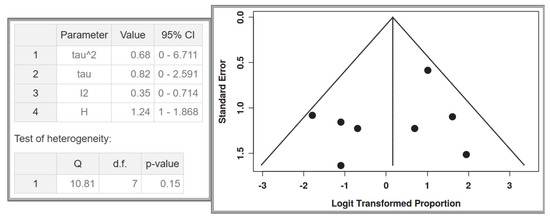
Figure 8.
Heterogeneity test and funnel plot interrogating dataset 2.
3.1.3. Dataset 3: Simple/Solitary SI-GISTs in the Number of GISTs with NF-1 Cases
A total of eight studies were included in the analysis, comprising 42 recorded cases [52,53,54,55,56,61,62,63]. The analysis for the pooled estimate of the proportion of simple/solitary GIST cases among GIST + NF-1 per study was based on random-effects models and the inverse variance method after logarithmic transformation. The pooled proportion estimate is 0.41 with a 95% confidence interval (0.24–0.60). The values for each study are presented in Table 5 below and are graphically represented in the forest plot (Figure 9), along with the pooled estimate and heterogeneity indices. The heterogeneity test among studies presented in Figure 10 showed an I2 value of 18%, which is not statistically significant with p = 0.29. Testing for publication bias using the funnel plot indicates symmetry (Figure 10), which supports the conclusion that there is no major effect of the selection of specific studies on the results.

Table 5.
Source studies contributing to dataset 3.

Figure 9.
Dataset 3 forest plot [52,53,54,55,56,61,62,63].
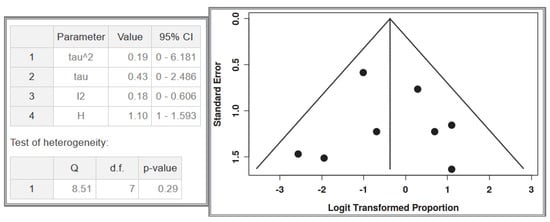
Figure 10.
Heterogeneity test and funnel plot interrogating dataset 3.
3.1.4. Dataset 4: Simple/Solitary SI-GISTs in the Total Number of Patients with NF-1
A total of seven studies were included in the analysis, comprising 1032 recorded cases [53,54,55,56,61,62,63]. The analysis for the pooled estimate of the proportion of simple/solitary GIST cases among NF-1 patients per study was based on random-effects models and the inverse variance method after logarithmic transformation. The pooled proportion estimate is 0.02 with a 95% confidence interval (0.01–0.04). The values for each study are presented in Table 6 and are graphically represented in the forest plot (Figure 11), along with the pooled estimate and heterogeneity indices. The heterogeneity test among studies presented in Figure 12 showed an I2 value of 49%, which is not statistically significant with p = 0.07. Testing for publication bias using the funnel plot indicates symmetry (Figure 12), which supports the conclusion that there is no major effect of the selection of specific studies on the results.

Table 6.
Source studies contributing to dataset 4.

Figure 11.
Dataset 4 forest plot [53,54,55,56,61,62,63].
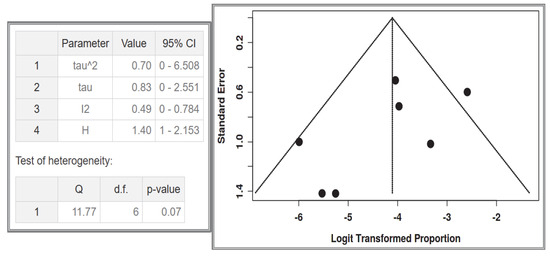
Figure 12.
Heterogeneity test and funnel plot interrogating dataset 4.
3.1.5. Dataset 5: Sporadic SI-GISTs in the General Population
A total of 15 studies [64,65,66,69,72,73,75,77,78,79,80,81,82,83,89,93] were included in the analysis, comprising 168,750,000 recorded cases. In the following table and graphs, the values are expressed in thousands of recorded cases. The analysis for the pooled estimate of the proportion of small intestinal GIST cases in the general population per study was based on random-effects models and the inverse variance method after logarithmic transformation. The pooled proportion estimate is 0.00002 with a 95% confidence interval (0.00001–0.00004). The values for each study are presented in the Table 7 below and are graphically represented in the forest plot (Figure 13), along with the pooled estimate and heterogeneity indices. The heterogeneity test among studies presented in Figure 14 showed an I2 value of 99%, which is statistically significant with p < 0.001. The assessment for publication bias using the funnel plot indicates a lack of symmetry (Figure 14), supporting the conclusion that there is an impact from the selection of the included studies on the results. However, even in the very large studies, the prevalence of small intestinal GISTs remains very low.

Table 7.
Source studies contributing to dataset 5.
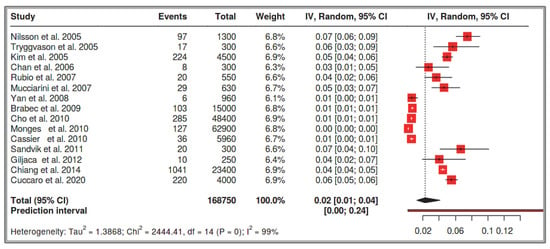
Figure 13.
Dataset 5 forest plot [64,65,66,69,72,73,75,77,78,79,80,81,82,83,89].
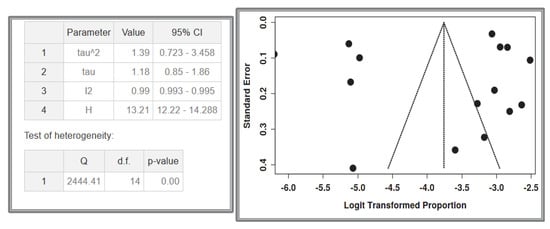
Figure 14.
Heterogeneity test and funnel plot interrogating dataset 5.
4. Discussion
The multifocal occurrence of GISTs in NF-1 patients presents a significant challenge for clinicians [32,33]. These tumors are primarily located in the small intestine, making endoscopic intervention difficult [6,7,30,31,32]. A common complication of these tumors is bleeding [36,37,38,39,40,41] and while embolization may achieve hemostasis, the anatomical constraints of small-bowel vasculature pose unique risks: distal occlusions carry elevated necrosis potential, whereas proximal embolization risks both ischemic injury and rebleeding via collateral circulation [94]. Identifying the exact bleeding source is challenging due to the high motility of the small intestine, which can promote the contrast agent distally, leading to mislocalization [44,95]. Imaging techniques often yield false-positive results [44,95]. Additionally, embolization of small intestinal branches can be difficult due to catheterization challenges, and furthermore, in many cases, these tumors are located in the distal segments of the small intestine [96,97]. Definitive diagnosis of the bleeding site can only be achieved through intraoperative endoscopy [44,95,98].
Despite endoscopic success, these tumors remain resistant to treatment with monoclonal agents such as imatinib [99,100]. Thus, conservative management aiming at tumor size reduction is highly challenging, and surgical resection is often the final solution [16,17]. Since NF-1 patients have a predisposition to developing GISTs in different segments of the small intestine over time, surgical resections should be limited. This is because, similar to Crohn’s disease, extensive resections can rarely lead to short bowel syndrome [100,101,102]. Thus, of particular urgency are cases presenting with acute intestinal obstruction or traction-induced intussusceptions; clinical scenarios that demand immediate intervention yet risk precipitating short bowel syndrome when multifocal lesions preclude radical resection. The work of Calomino et al. poignantly illustrates this dilemma: their two NF1-associated emergency resections (for ischemic presentations mimicking infarct) resulted in ultrashort bowel remnants (40–50 cm) with sacrificed ileocecal valves, yet through staged nutritional rehabilitation, transitioning from TPN to enteral to oral intake, both patients achieved long-term nutritional independence with preserved quality of life. These emergent presentations, albeit sporadically encountered, pose unique therapeutic dilemmas: obstruction from bulky tumors may necessitate expedited surgery despite the specter of recurrent disease, while intussusceptions mandate careful consideration of resection margins to avoid compromising bowel length [103]. Special attention should be given to tumor size, as it is the only macroscopic criterion for neoplastic progression in NF-1 patients with small intestinal involvement [104].
The prevalence of NF-1 in the general population is 1 in 3000–3500 individuals [9,10]. Some researchers suggest that 4–25% of NF-1 patients will develop a GIST at some point in their lives [31]. In a 1963 study from Ohio State University Hospital [30], patients were examined from two distinct periods: (i) clinical cases from 1949 to 1960, where 4% (1/29) of NF-1 patients had clinically evident GISTs, and(ii) autopsy cases from 1937 to 1960, where 25% (3/12) of generalized neurofibromatosis cases showed GISTs—establishing the aforementioned 4–25% range. However, this percentage is often reported to be much lower in the literature. Miettinen et al. (2006) emphasize that the 25% estimate is extremely high, as it is based on an older autopsy study that overestimates the GIST prevalence in NF-1 patients [7,30]. On the other hand, since the mean age of GIST onset in NF-1 patients is over 50 years, and NF-1 is now diagnosed at a young age, a large proportion of NF1-associated GIST cases remain unrecorded [53]. Thus, the prevalence of GISTs in NF-1 patients is often underestimated in modern studies [53]. Dupuis et al. (2023) highlight this issue in a cohort study, explaining that the prevalence of GISTs in NF-1 patients in their study is 3.7% [53], attributing the underestimation to the mean age of their study population (37.5 years) [53]. Most of the studies included in our meta-analysis have a mean patient age below 40 years. It is well known that the most common site of GISTs in NF-1 patients is the small intestine [6,7,30,31,32,33]. Some researchers suggest that almost all NF-1 patients with GISTs will eventually develop a GIST in the small intestine. Specifically, Mussi (2008) reports a 75% rate [32], while Salvi (2013) estimates 90% overall [33]. Our systematic review focuses exclusively on the small intestine. It analyzed 1386 recorded NF-1 cases and found that the prevalence of small intestine GISTs in NF-1 patients is 3%, with a confidence interval of 2–5%. Among these, 54% were multifocal, 41% were solitary small intestine GISTs, and the remainders were solitary duodenal GISTs. The prevalence of solitary small intestine and duodenal GISTs combined in the total NF-1 cases was approximately 2% (1–4%). This observation is supported by multiple researchers who describe that half of NF-1 patients with GISTs have multifocal small intestine GISTs, while the other half have solitary tumors [54,55]. However, these prevalence estimates provide only a fragmented picture of NF-1 patients’ lifetime risk. Over time, all GIST cases in NF-1 patients tend to become multifocal, as the likelihood of developing additional GISTs in other small intestinal segments is very high, as we will discuss further [32,33]. On the other hand, the prevalence of sporadic GISTs in the general population is approximately 12 per 100,000 individuals [64]. About one-third (30%) of these sporadic GIST cases occur in the small intestine, with the most common site being the stomach [105]. Chan et al. (2006) report an even lower proportion of sporadic small intestinal GISTs, estimating it at around 17% [69]. Among all sporadic GIST cases, less than 5% are associated with NF-1 mutations [106]. It is noteworthy that NF-1 patients are often excluded from general sporadic GIST registries, as their GIST cases are frequently multifocal and suggestive of rare syndromes [35]. One such syndrome is intestinal neurofibromatosis, a subtype of familial GISTs associated with PGFRA mutations [35]. These patients often lack external neurofibromatosis signs, and their disease first manifests with gastrointestinal symptoms [35]. Furthermore, many sporadic GIST cases that undergo genetic testing do not exhibit KIT gene mutations, even though many are CD117(+) [64]. When a GIST is quadruple-negative (negative for KIT, PDGFRA, BRAF, and SDH), there is a high likelihood of undiagnosed NF-1 [107]. It has been proposed that NF-1-associated GISTs should be identified not by genetic testing, but by monoclonal antibody assays that assess neurofibromin activity, as some mutations contribute to neurofibromin dysfunction without being genetically detectable [108]. Lastly, some GIST cases remain asymptomatic and go undiagnosed, despite NF-1 diagnosis being much easier today, primarily occurring in childhood [13,14,35]. As a result, many researchers report a much lower NF-1-related GIST prevalence, emphasizing that less than 1% of all recorded sporadic GIST cases are actually NF-1-associated [6,7]. In our meta-analysis, which focuses specifically on the small intestine, the prevalence of sporadic small intestine GISTs in a total of 168,750,000 recorded cases was 2 per 100,000 (1–4 per 100,000). Although the studies differ and a subgroup meta-analysis could not be performed due to the low number of NF-1-associated GIST cases, it is evident that the prevalence of small intestinal GISTs in NF-1 patients is significantly higher than that of sporadic small intestinal GISTs. This is apparent even for solitary small intestinal GISTs and duodenal GISTs, which share the same clinical and potentially pathogenic pathway as sporadic small intestinal GISTs (2% vs. 2 per 100,000). Nishida et al. (2016) report that the incidence of GISTs in NF-1 patients is 200 times higher than sporadic GIST [54]. If research focuses exclusively on the small intestine, this ratio may be much higher (potentially three times greater), since nearly all GISTs in NF-1 patients occur in the small intestine, whereas only one-third of sporadic small intestinal GIST cases do [64]. It is also important to emphasize that the incidence of NF-1-associated GISTs is very different and cannot be accurately determined, especially in comparison with sporadic GISTs. This is due to the different life expectancy of each patient group, the underreporting of many cases due to diagnostic challenges, and the wide time span covered by patient registries.
It is well known that neurofibromatosis is a disease caused by a mutation in the NF-1 gene, located on chromosome 17q11.2, following an autosomal dominant inheritance pattern [13,14]. The GISTs in NF-1 patients are CD117/DOG1 (+), despite the absence of KIT/PGFRA mutations (Figure 15) [2,3].
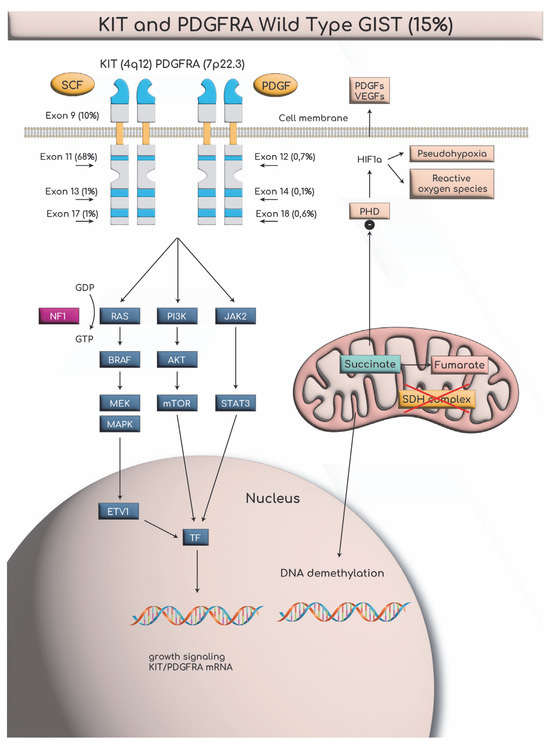
Figure 15.
Beyond KIT/PDGFRA: the distinct molecular signature of the NF-1 tumor microenvironment in GIST pathobiology (SCF; Stem Cell Factor, VEGF; Vascular Endothelial Growth Factor, HIF1a; Hypoxia Inducible Factor 1a, PHD; Prolyl Hydroxylase Domain, GDP/GTP; Guanosine Diphosphate/Triphosphate, ETV1; ETS Variant transcription factor 1, MTOR; mammalian Target Of Rapamycin, TF; Transcription Factor).
These tumors belong to the wild-type (15%) GIST category and result from germline mutations, specifically in the NF-1 gene mentioned earlier [8]. Maertens (2006) precisely described the molecular pathogenesis of GISTs in NF-1 patients and explained why these tumors occur at a much higher frequency compared to the general population, as well as why they are often multifocal [109]. Neurofibromin functions as a negative regulator of the RAS/MAPK pathway by catalyzing the hydrolysis of active Ras-GTP into inactive Ras-GDP. Active RAS binds to BRAF or the proto-oncogene RAF-1 at a specific Ras-binding domain (RBD) in BRAF, which is a serine/threonine kinase. This leads to RAF activation through homo- and heterodimerization [110]. Activated RAF subsequently triggers the MAPK pathway, leading to growth signaling activation through KIT/PGFRA mRNA expression. This mechanism explains why GISTs in NF-1 patients are CD117 (+), albeit indirectly. However, in this case, KIT exhibits extremely low levels of systemic autophosphorylation (constitutive autophosphorylation). Neurofibromin does not actively participate in somatic mutations. Additionally, the JAK-STAT3 and PI3K-AKT pathways are less active in NF-1-associated GIST cases. Despite these major molecular differences, the MAPK pathway remains common to both sporadic GISTs and NF-1-associated GISTs [109]. All conditions resulting from RAS/MAPK pathway dysregulation are classified as RASopathies. RASopathies are genetic syndromes caused by germline mutations in genes encoding components of the RAS/MAPK signaling pathway [110]. Besides NF-1, other RASopathies include Noonan syndrome, Costello syndrome, and Legius syndrome. A wide variety of tumors can develop in these syndromes, including neuroblastoma, acute lymphoblastic leukemia (ALL), non-Hodgkin’s lymphoma (NHL), acute myeloid leukemia (AML), non-small-cell lung cancer, tubulovillous adenomas of the colon, breast cancer, ovarian dermoid tumors, and even melanoma. It is well established that multiple distinct genes contribute to the development of these tumors. Recently, the role of the BRAF gene in BRAF-associated RASopathies has been extensively described [110].
The mechanism by which some GISTs develop as solitary tumors while others become multifocal has not yet been fully elucidated. In our meta-analysis, we found that 41% of cases presented as solitary GISTs, while 54% were multifocal GISTs. Additionally, NF-1 patients may develop multiple solitary GISTs, making the distinction between the two categories unclear [54,55]. Chen et al. (2002) studied the nature of these multifocal tumors, investigating whether their origin is polyclonal or monoclonal, which would indicate hyperplasia or neoplasia, respectively [111]. The study concluded that familial and multiple GISTs result from hyperplasia of interstitial cells of Cajal, categorizing them as non-neoplastic diffuse ICC hyperplasia. However, tumors larger than 5 mm appeared to have a monoclonal nature, suggesting neoplastic transformation. An intermediate stage between hyperplasia and neoplasia is the formation of micro-GISTs, measuring 1–10 mm [112]. For this reason, apart from mitotic count and markers such as Ki67, tumor size is the only macroscopic criterion suggestive of neoplasia, which has been incorporated into GIST staging systems [104]. The biological continuum from polyclonal hyperplasia to monoclonal neoplasia mandates a multidisciplinary approach—integrating serial endoscopic surveillance for subcentimeter lesions, Ki67-indexed risk stratification, and judicious surgical intervention—to optimize the critical transition from oncologic vigilance to therapeutic action while preserving intestinal function. Surgeons must keep this in mind, as extensive and multiple resections in the small intestine may ultimately cause significant morbidity in NF-1 patients without necessarily increasing oncologic risk. Recently, the role of selumetinib and mirdametinib in the treatment of plexiform neurofibromas has been recognized, primarily for clinical symptom improvement [113,114]. However, their role in GIST downstaging in NF-1 patients has not yet been investigated. As a result, surgical resection remains the only available treatment for NF-1-associated GISTs, in a patient population already undergoing multiple surgical procedures [16,17].
The most common site of GISTs in NF-1 patients is the small intestine, whereas in sporadic GISTs, only one-third of cases present as small intestinal GISTs [32,33,64]. This remains a scientific question related to the GIST cell of origin [112]. It is widely known that interstitial cells of Cajal are responsible for GIST development [1]. However, even these cells have different subtypes with varying distributions depending on the intestinal segment and layer in which they are located [115]. Additionally, they exhibit differential expression of the transcription factor ETV1 (E twenty-six), which is a lineage transcription factor that plays a crucial role in GIST formation [116]. There are myenteric (ICC-MYs) and intramuscular (ICC-IMs) ICCs, as well as submucosal ICCs (ICC-SMPs) and deep myenteric plexus ICCs (ICC-DMPs) [1]. In the colon, ICC-MYs and ICC-IMs stain positive for ETV1, but ICC-SMPs do not [116]. In the small intestine, ICC-MYs stain positive for ETV1, but ICC-DMPs do not [116]. In experimental models with KIT gene mutations, ICC-MYs and ICC-IMs undergo hyperplasia, whereas ICC-SMPs and ICC-DMPs do not [116]. Another recent study based on animal models suggests that the progenitor cells of GISTs are smooth muscle cell progenitors, which undergo genetic deviation, leading to GIST formation [117]. This has introduced the alternative cell of origin theory for GISTs [117]. Such progenitor cells are primarily ICC-DMPs and ICC-SMPs, which eventually develop ICC hyperplasia following differentiation influenced by LRIF1 (Ligand-dependent nuclear Receptor-Interacting Factor 1) and BRAF V600E [117]. It is well known that ICC-DMPs are widely distributed in the small intestine, particularly in the jejunum and ileum [118]. Moreover, studies in genetically modified W/Wv mice with c-KIT mutations (ICC-deficient model mice) have shown that the only preserved myenteric plexus detectable microscopically was the ICC-DPMs in the ileum, while in contrast, ICC-IMs in the gastric antrum and colon were absent [119]. However, for ICC hyperplasia to progress into oncogenesis, multiple genetic mechanisms must be involved. Ran et al. (2017) successfully induced both ICC hyperplasia and multifocal GIST formation in the gastrointestinal tract of mice by activating the BRAF V600E gene and simultaneously deleting Trp53 (tryptophan 53) [116]. The activation of BRAF V600E in ETV1(+) cells resulted only in ICC hyperplasia, without malignant transformation. However, the additional loss of the tumor suppressor gene Trp53 led to progression from hyperplasia to malignancy, resulting in the formation of multiple GISTs throughout the gastrointestinal tract [116]. Notably, the experimental model achieved 100% success in mice [116]. Thus, not only does the cell of origin influence GIST formation, but a specific genetic combination is also required for malignant transformation. This explains why the phenotype of GISTs in multifocal syndromes cannot be fully elucidated. Some tumors are clearly GISTs with CD117(+) expression and do not exhibit the CD117(−), S100(−), SMA(−), or desmin(−) phenotype characteristic of mesenchymal tumors derived from smooth muscle cells [120].
The integration of prognostic scoring systems has become indispensable for stratifying survival outcomes and metastatic risk in GIST management, with particular relevance for NF1-associated cases. The recently developed RECKGIST score represents a transformative advance in this domain, offering NF1-specific risk stratification that surpasses conventional classification systems in predictive accuracy. As demonstrated by Cuvelier et al., this tool effectively discriminates low-risk from high-risk cohorts based on critical histopathological parameters, enabling more nuanced clinical decision-making. Notably, the score’s robust differentiation of recurrence risk underscores its potential to refine surveillance protocols and therapeutic interventions for NF1 patients. While further validation is warranted, RECKGIST emerges as a paradigm-shifting framework that addresses longstanding gaps in the prognostication of NF1-GIST behavior [121].
This meta-analysis has several limitations. Firstly, it has a moderate risk of bias, primarily due to the limited number of patients included in each study and the potential selection bias in individual studies. The novelty of this study lies in its exclusive focus on small intestinal GISTs and the comparison between NF-1 patients and the general population. However, due to the fact that the included studies were heterogeneous, no subgroup meta-analysis with specific statistical tools was performed; instead, we relied on direct percentage comparisons, which clearly showed a significant difference between the two groups. The focus on the small intestine, while strength of the study, is also a limitation, as GIST occurrence in other gastrointestinal sites was not extensively analyzed. This decision was made to avoid overcomplicating the review, taking into consideration that this aspect has already been extensively studied in the past. The primary objective of this study was to emphasize the clinical challenges associated with small intestinal GISTs, particularly endoscopic accessibility. Additionally, this systematic review aims to provide indirect insights into the molecular pathogenesis of GISTs, proposing a potential explanation for the origin of GIST cells, which may be predominantly located in the small intestine. A key issue in this research area is the molecular mechanisms driving multifocal tumors in NF-1 mutations, which is a turning point in the broader study of GIST pathogenesis. Although significant progress has been made in this field, research has primarily focused on the increased prevalence of GISTs in NF-1 patients, rather than differentiating between multifocal/hyperplasic and solitary/neoplastic GISTs. Furthermore, the transition from hyperplasia to neoplasia requires further investigation through new studies. Most research on this topic remains limited to animal models. Future studies are expected to address these unanswered questions, which will have a direct impact on the clinical management of these patients. More specifically, the development of molecular biomarkers to preoperatively distinguish multifocal hyperplasia from solitary neoplasia could revolutionize surgical planning in NF-1 patients. Precision surveillance protocols must be established to detect the earliest transition from Cajal cell hyperplasia to clonal neoplasia, particularly in high-risk intestinal segments. Last but not least, the creation of evidence-based decision algorithms integrating tumor focality, mutational status, and anatomical constraints will be paramount for optimizing both oncological outcomes and bowel function preservation. These translational imperatives—now crystallized by our systematic evidence synthesis—chart an actionable roadmap for transforming NF-1-GIST management from reactive intervention to proactive precision medicine.
5. Conclusions
Following this elaborative analysis, it emerges that small intestine gastrointestinal stromal tumors (SI-GISTs) demonstrate unique characteristics in neurofibromatosis type 1 (NF-1) patients that merit careful consideration. The prevalence of SI-GISTs in NF-1 patients is established at 3% (range 2–5%), presenting a clear epidemiological benchmark. Among these cases, a distinct pattern emerges: 54% manifest as multifocal SI-GISTs and 41% as solitary SI-GISTs, with the remaining cases representing solitary duodenal GISTs. When examining solitary SI-GISTs specifically, the prevalence in NF-1 patients approximates 2% (1–4%), providing further granularity to our understanding. These figures gain particular significance when contrasted with the general population’s sporadic small intestinal GIST prevalence of merely 2 per 100,000 individuals, revealing that NF-1 patients face a substantially elevated risk (3% versus 0.002%).
This systematic review, with its exclusive focus on small intestinal manifestations, compellingly demonstrates that the propensity for SI-GIST development in NF-1 patients far exceeds prior estimations compared to the general population. The notably high frequency of SI-GISTs in NF-1 patients, coupled with their multifocal nature, offers invaluable insights that may illuminate both the cellular origins of GISTs and the fundamental pathogenic mechanisms governing GIST tumorigenesis. From a clinical perspective, these findings carry immediate practical implications: when evaluating NF-1 patients presenting with gastrointestinal bleeding, physicians must maintain heightened suspicion for underlying small intestinal tumors, as these cases presents unique challenges in diagnosis and management.
The management challenges are multifaceted, encompassing difficulties in precise bleeding site localization, constraints on endoscopic intervention options, limited efficacy of tyrosine kinase inhibitors (KIT inhibitors) in tumor downstaging, and complex intraoperative decision-making regarding resection of potential neoplastic foci. Together, these groundbreaking revelations not only revolutionize our understanding of GIST pathogenesis but sound an urgent clarion call for the immediate implementation of specialized diagnostic algorithms, tailored therapeutic strategies, and rigorous surveillance protocols to safeguard NF-1 patients from this insidious and disproportionately prevalent malignancy.
Author Contributions
Conceptualization, I.K. and C.S.K.; methodology, S.M.; software, V.A.K.; validation, S.M., V.A.K. and P.R.; formal analysis, S.M., V.A.K., C.S. and S.S.; investigation, S.M., C.S. and S.S.; resources, C.S., S.S. and P.R.; data curation, S.M.; writing—original draft preparation, S.M. and V.A.K.; writing—review and editing, S.M., V.A.K., G.A., K.P., V.M. and N.V.; visualization, S.M. and V.A.K.; supervision, C.S.K.; project administration, I.K. All authors have read and agreed to the published version of the manuscript.
Funding
This research received no external funding.
Institutional Review Board Statement
The datasets analyzed in this study were derived from publicly accessible sources that had previously received proper ethical review and approval.
Informed Consent Statement
Not applicable; this research synthesizes findings from prior published studies through a comprehensive meta-analysis, utilizing existing datasets without the need for additional human participant involvement. Consequently, ethical approval and informed consent were deemed unnecessary, as no new primary data collection was conducted.
Data Availability Statement
To facilitate research reproducibility, the aggregated data from this meta-analysis can be provided by the corresponding author following established data sharing protocols. Link to the PROSPERO international systematic review registry: https://www.crd.york.ac.uk/PROSPERO/view/CRD420251002384, accessed on 15 March 2025.
Conflicts of Interest
The authors declare no conflicts of interest.
Abbreviations
The following abbreviations are used in this manuscript in alphabetical order:
| BRAF | B-Rapidly Accelerated Fibrosarcoma Protein |
| CIMP | CpG Island Methylator Phenotype |
| ETV1 | ETS Variant transcription factor 1 |
| GIST | Gastrointestinal Stromal Tumor |
| HIF1a | Hypoxia Inducible Factor 1a |
| JAK-STAT3 | Janus Kinase/Signal Transducer and Activator of Transcription |
| KIT | Proto-oncogene, Receptor Tyrosine Kinase |
| LRIF1 | Ligand-Dependent Nuclear Receptor-Interacting Factor 1 |
| MEK/MAPK | Mitogen-Activated Protein Kinase |
| mTOR | mammalian Target Of Rapamycin |
| NF-1 | Neurofibromatosis Type 1 |
| PDGFRA | Platelet-Derived Growth Factor Receptor Alpha |
| PHD | Prolyl Hydroxylase Domain |
| PICO | Patients, Interventions, Comparison Groups, Outcomes |
| PI3K-AKT | Phosphoinositide 3-Kinase/Protein Kinase B |
| ROBINS-E | Risk of Bias in Non-Randomized Studies of Exposures |
| SCF | Stem Cell Factor |
| SDH | Succinate Dehydrogenase |
| SI-GIST | Small Intestinal Gastrointestinal Stromal Tumor |
| VEGF | Vascular Endothelial Growth Factor |
References
- Radu, P.; Zurzu, M.; Paic, V.; Bratucu, M.; Garofil, D.; Tigora, A.; Georgescu, V.; Prunoiu, V.; Popa, F.; Surlin, V.; et al. Interstitial Cells of Cajal-Origin, Distribution and Relationship with Gastrointestinal Tumors. Medicina 2022, 59, 63. Available online: https://pubmed.ncbi.nlm.nih.gov/36676686/ (accessed on 17 March 2025). [CrossRef] [PubMed]
- Niinuma, T.; Suzuki, H.; Sugai, T. Molecular characterization and pathogenesis of gastrointestinal stromal tumor. Transl. Gastroenterol. Hepatol. 2018, 3, 2. Available online: https://pubmed.ncbi.nlm.nih.gov/29441367/ (accessed on 17 March 2025). [CrossRef] [PubMed]
- Unk, M.; Novaković, B.J.; Novaković, S. Molecular Mechanisms of Gastrointestinal Stromal Tumors and Their Impact on Systemic Therapy Decision. Cancers 2023, 15, 1498. Available online: https://pubmed.ncbi.nlm.nih.gov/36900287/ (accessed on 17 March 2025). [CrossRef]
- Hirota, S.; Isozaki, K.; Moriyama, Y.; Hashimoto, K.; Nishida, T.; Ishiguro, S.; Kawano, K.; Hanada, M.; Kurata, A.; Takeda, M.; et al. Gain-of-function mutations of c-kit in human gastrointestinal stromal tumors. Science 1998, 279, 577–580. Available online: https://pubmed.ncbi.nlm.nih.gov/9438854/ (accessed on 17 March 2025). [CrossRef]
- Serrano, S.; Broto, J.M.; Pascual, J.M.A.; Guerrero, J.A.L.; Casadevall, J.R.; Bague, S.; Muro, X.G.D.; Hernandez, J.A.F.; Herrero, L.; Pousa, A.L.; et al. 2023 GEIS Guidelinesfor gastrointestinal stromaltumors. Ther. Adv. Med. Oncol. 2023, 15, 17588359231192388. Available online: https://pubmed.ncbi.nlm.nih.gov/37655207/ (accessed on 17 March 2025). [CrossRef]
- Miettinen, M.; Kopczynski, J.; Makhlouf, H.R.; Sarlomo-Rikala, M.; Gyorffy, H.; Burke, A.; Sobin, L.H.; Lasota, J. Gastrointestinal stromal tumors, intramural leiomyomas, and leiomyosarcomas in the duodenum: A clinicopathologic, immunohistochemical, and molecular genetic study of 167 cases. Am. J. Surg. Pathol. 2003, 27, 625–641. Available online: https://pubmed.ncbi.nlm.nih.gov/12717247/ (accessed on 17 March 2025). [CrossRef]
- Miettinen, M.; Fetsch, J.F.; Sobin, L.H.; Lasota, J. Gastrointestinal stromal tumors in patients with neurofibromatosis 1: A clinicopathologic and molecular genetic study of 45 cases. Am. J. Surg. Pathol. 2006, 30, 90–96. Available online: https://pubmed.ncbi.nlm.nih.gov/16330947/ (accessed on 17 March 2025). [CrossRef]
- Wu, C.-E.; Tzen, C.-Y.; Wang, S.-Y.; Yeh, C.-N. Clinical Diagnosis of Gastrointestinal Stromal Tumor (GIST): From the Molecular Genetic Point of View. Cancers 2019, 11, 679. Available online: https://pubmed.ncbi.nlm.nih.gov/31100836/ (accessed on 17 March 2025). [CrossRef] [PubMed]
- Kallionpää, R.A.; Uusitalo, E.; Leppävirta, J.; Pöyhönen, M.; Peltonen, S.; Peltonen, J. Prevalence of neurofibromatosis type 1 in the Finnish population. Genet. Med. 2018, 20, 1082–1086. Available online: https://pubmed.ncbi.nlm.nih.gov/29215653/ (accessed on 17 March 2025). [CrossRef]
- Lee, T.-S.J.; Chopra, M.; Kim, R.H.; Parkin, P.C.; Barnett-Tapia, C. Incidence and prevalence of neurofibromatosis type 1 and 2: A systematic review and meta-analysis. Orphanet J. Rare Dis. 2023, 18, 1–8. Available online: https://pubmed.ncbi.nlm.nih.gov/37710322/ (accessed on 17 March 2025). [CrossRef]
- Recklinghausen, Friedrich von, Ueber die multiplen Fibrome der Haut und ihre Beziehungzu den multiplen Neuromen: Festschrift zur Feier des fünfundzwanzigjährigen Bestehens des pathologischen Instituts zu Berlin Herrn Rudolf Virchow: 1833–1910: Free Download, Borrow, and Streaming: Internet. Available online: https://archiv.org/details/ueberdiemultiple00reck (accessed on 17 March 2025).
- Brosius, S. A history of von Recklinghausen’s NF1. J. Hist. Neurosci. 2010, 19, 333–348. Available online: https://pubmed.ncbi.nlm.nih.gov/20938857/ (accessed on 17 March 2025). [CrossRef] [PubMed]
- Karaconji, T.; Whist, E.; Jamieson, R.V.; Flaherty, M.P.; Grigg, J.R.B. Neurofibromatosis Type 1: Review and Update on Emerging Therapies. Asia-Pac. J. Ophthalmol. 2019, 8, 62–72. Available online: https://pubmed.ncbi.nlm.nih.gov/30387339/ (accessed on 17 March 2025).
- Bergqvist, C.; Servy, A.; Valeyrie-Allanore, L.; Ferkal, S.; Combemale, P.; Wolkenstein, P. Neurofibromatosis 1 French national guidelines based on an extensive literature review since 1966. Orphanet J. Rare Dis. 2020, 15, 1–23. Available online: https://pubmed.ncbi.nlm.nih.gov/32014052/ (accessed on 17 March 2025). [CrossRef] [PubMed]
- Shilyansky, C.; Lee, Y.; Silva, A. Molecular and cellular mechanisms of learning disabilities: A focus on NF1. Annu. Rev. Neurosci. 2010, 33, 221–243. Available online: https://pubmed.ncbi.nlm.nih.gov/20345245/ (accessed on 17 March 2025). [CrossRef]
- Ota, M.; Nobeyama, Y.; Asahina, A. Real-world Settings for the Surgical Treatment of Neurofibroma in Patients with Neurofibromatosis Type 1. JMA J. 2024, 7, 205–212. Available online: https://pubmed.ncbi.nlm.nih.gov/38721077/ (accessed on 17 March 2025).
- Parsons, C.M.; Canter, R.J.; Khatri, V.P.P. Surgical management of neurofibromatosis. Surg. Oncol. Clin. N. Am. 2009, 18, 175–196. Available online: https://pubmed.ncbi.nlm.nih.gov/19056048/ (accessed on 17 March 2025). [CrossRef]
- Hamoy-Jimenez, G.; Kim, R.; Suppiah, S.; Zadeh, G.; Bril, V.; Barnett, C. Quality of life in patients with neurofibromatosis type 1 and 2 in Canada. Neuro-Oncol. Adv. 2020, 2, i141–i149. Available online: https://pubmed.ncbi.nlm.nih.gov/32642740/ (accessed on 17 March 2025). [CrossRef]
- Yoo, H.K.; Porteous, A.; Ng, A.; Haria, K.; Griffiths, A.; Lloyd, A.; Yang, X.; Kazeem, G.; Barut, V. Impact of neurofibromatosis type 1 with plexiform neurofibromas on the health-related quality of life and work productivity of adult patients and caregivers in the UK: A cross-sectional survey. BMC Neurol. 2023, 23, 1–10. Available online: https://pubmed.ncbi.nlm.nih.gov/37996843/ (accessed on 17 March 2025). [CrossRef]
- Bäzner, U.; Stauss, L.; Kapapa, T.; Wirtz, C.R.; Pala, A. Quality of life of patients with neurofibromatosis 1-Physical disability does not necessarily result in poor mental health. Front. Neurol. 2024, 15, 1432196. Available online: https://pubmed.ncbi.nlm.nih.gov/39539654/ (accessed on 17 March 2025). [CrossRef]
- Kallionpää, R.A.; Johansson, E.; Böckerman, P.; Peltonen, J.; Peltonen, S. The contribution of morbidity and unemployment for the reduced labor market participation of individuals with neurofibromatosis 1 in Finland. Eur. J. Hum. Genet. 2023, 32, 83–90. Available online: https://pubmed.ncbi.nlm.nih.gov/37460655/ (accessed on 17 March 2025). [CrossRef]
- Diaz, E.; Bergqvist, C.; Peiffer, B.; Fertitta, L.; Jannic, A.; Ferkal, S.; Zehou, O.; Hemery, F.; Sbidian, E.; Wolkenstein, P. In-Hospital Clinical Features, Morbidity, and Mortality of Patients with Neurofibromatosis 1 in France: A Nationwide, Population-Based Retrospective Cohort Study. J. Investig. Dermatol. 2023, 143, 2408–2415.e7. Available online: https://pubmed.ncbi.nlm.nih.gov/37257636/ (accessed on 17 March 2025). [CrossRef] [PubMed]
- Evans, D.G.R.; O‘Hara, C.; Wilding, A.; Ingham, S.L.; Howard, E.; Dawson, J.; Moran, A.; Scott-Kitching, V.; Holt, F.; Huson, S.M. Mortality in neurofibromatosis 1: In North West England: An assessment of actuarial survival in a region of the UK since 1989. Eur J. Hum. Genet. 2011, 19, 1187–1191. Available online: https://pubmed.ncbi.nlm.nih.gov/21694737/ (accessed on 17 March 2025). [CrossRef] [PubMed]
- Carton, C.; Evans, D.G.; Blanco, I.; Friedrich, R.E.; Ferner, R.E.; Farschtschi, S.; Salvador, H.; Azizi, A.A.; Mautner, V.; Röhl, C.; et al. ERN GENTURIS tumour surveillance guidelines for individuals with neurofibromatosis type 1. eClinicalMedicine 2023, 56, 101818. Available online: https://pubmed.ncbi.nlm.nih.gov/36684394/ (accessed on 17 March 2025). [CrossRef] [PubMed]
- de Souza, J.F.; de Toledo, L.L.; Ferreira, M.C.M.; Rodrigues, L.O.C.; de Rezende, N.A. Neurofibromatosis type 1: More frequent and severe then usually though. Rev. Assoc. Médica Bras. 2009, 55, 394–399. Available online: https://pubmed.ncbi.nlm.nih.gov/19750304/ (accessed on 17 March 2025).
- Li, F.; Munchhof, A.M.; White, H.A.; Mead, L.E.; Krier, T.R.; Fenoglio, A.; Chen, S.; Wu, X.; Cai, S.; Yang, F.-C.; et al. Neurofibromin is a novel regulator of RAS-induced signals in primary vascular smooth muscle cells. Hum. Mol. Genet. 2006, 15, 1921–1930. Available online: https://pubmed.ncbi.nlm.nih.gov/16644864/ (accessed on 17 March 2025). [CrossRef]
- Hirata, Y.; Brems, H.; Suzuki, M.; Kanamori, M.; Okada, M.; Morita, R.; Llano-Rivas, I.; Ose, T.; Messiaen, L.; Legius, E.; et al. Interaction between a Domain of the Negative Regulator of the Ras-ERK Pathway, SPRED1 Protein, and the GTPase-activating Protein-related Domain of Neurofibromin Is Implicated in Legius Syndrome and Neurofibromatosis Type 1. J. Biol. Chem. 2016, 291, 3124–3134. Available online: https://pubmed.ncbi.nlm.nih.gov/26635368/ (accessed on 17 March 2025). [CrossRef] [PubMed]
- Báez-Flores, J.; Rodríguez-Martín, M.; Lacal, J. The therapeutic potential of neurofibromin signaling pathways and binding partners. Commun. Biol. 2023, 6, 1–13. Available online: https://pubmed.ncbi.nlm.nih.gov/37081086/ (accessed on 17 March 2025). [CrossRef]
- Bergoug, M.; Doudeau, M.; Godin, F.; Mosrin, C.; Vallée, B.; Bénédetti, H. Neurofibromin Structure, Functions and Regulation. Cells 2020, 9, 2365. Available online: https://pubmed.ncbi.nlm.nih.gov/33121128/ (accessed on 17 March 2025). [CrossRef]
- Ghrist, T.D. Gastrointestinal involvement in neurofibromatosis. Arch. Intern. Med. 2016, 112, 357–362. Available online: https://pubmed.ncbi.nlm.nih.gov/14045280/ (accessed on 17 March 2025). [CrossRef]
- Pan, D.; Liang, P.; Xiao, H. Neurofibromatosis type 1 associated with pheochromocytoma and gastrointestinal stromal tumors: A case report and literature review. Oncol. Lett. 2016, 12, 637–643. Available online: https://pubmed.ncbi.nlm.nih.gov/27347193/ (accessed on 17 March 2025). [CrossRef]
- Mussi, C.; Schildhaus, H.-U.; Gronchi, A.; Wardelmann, E.; Hohenberger, P. Therapeutic consequences from molecular biology for gastrointestinal stromal tumor patients affected by neurofibromatosis type 1. Clin. Cancer Res. 2008, 14, 4550–4555. Available online: https://pubmed.ncbi.nlm.nih.gov/18628470/ (accessed on 17 March 2025). [CrossRef] [PubMed]
- Salvi, P.F.; Lorenzon, L.; Caterino, S.; Antolino, L.; Antonelli, M.S.; Balducci, G. Gastrointestinal stromal tumors associated with neurofibromatosis 1: A single centre experience and systematic review of the literature including 252 cases. Int. J. Surg. Oncol. 2013, 2013, 398570. Available online: https://pubmed.ncbi.nlm.nih.gov/24386562/ (accessed on 17 March 2025). [CrossRef] [PubMed]
- Menge, F.; Jakob, J.; Kasper, B.; Smakic, A.; Gaiser, T.; Hohenberger, P. Clinical Presentation of Gastrointestinal Stromal Tumors. Visc. Med. 2018, 34, 335–340. Available online: https://pubmed.ncbi.nlm.nih.gov/30498699 (accessed on 17 March 2025). [CrossRef]
- de Raedt, T.; Cools, J.; Debiec–Rychter, M.; Brems, H.; Mentens, N.; Sciot, R.; Himpens, J.; de Wever, I.; Schöffski, P.; Marynen, P.; et al. Intestinal neurofibromatosis is a subtype of familial GIST and results from a dominant activating mutation in PDGFRA. Gastroenterology 2006, 131, 1907–1912. Available online: https://pubmed.ncbi.nlm.nih.gov/17087943/ (accessed on 17 March 2025). [CrossRef] [PubMed]
- Zhuo, J.; He, P.; Ali, M.; Patel, A.V.; Kesavarapu, K. S4025 Bleeding GIST Suggestive of Undiagnosed Neurofibromatosis Type 1. Off. J. Am. Coll. Gastroenterol. ACG 2023, 118, S2557–S2558. Available online: https://journals.lww.com/ajg/fulltext/2023/10001/s4025_bleeding_gist_suggestive_of_undiagnosed.2704.aspx (accessed on 17 March 2025). [CrossRef]
- Mandalà, S.; Lupo, M.; Guccione, M.; La Barbera, C.; Iadicola, D.; Mirabella, A. Small bowel gastrointestinal stromal tumor presenting with gastrointestinal bleeding in patient with type 1 Neurofibromatosis: Management and laparoscopic treatmen Case report and review of the literature. Int. J. Surg. Case Rep. 2021, 79, 84–90. Available online: https://pubmed.ncbi.nlm.nih.gov/33444965/ (accessed on 17 March 2025). [CrossRef]
- Kalayanamitra, R.; Shahid, Z.; Shah, N.; Patel, R.; Jain, R. The Bleeding Bowel: A Rare Case of Neurofibromatosis Type 1-associated Gastrointestinal Stromal Tumor in a Young Male. Cureus 2019, 11, e4868. Available online: https://pmc.ncbi.nlm.nih.gov/articles/PMC6687427/ (accessed on 17 March 2025). [CrossRef]
- Hudgi, A.R.; Azam, M.; Masood, M.; Arshad, H.M.S.; Yap, J.E.L. The GIST of It: A Rare Presentation of Neurofibromatosis Type, I. Am. J. Gastroenterol. 2021, 13. Available online: https://pubmed.ncbi.nlm.nih.gov/34336521/ (accessed on 17 March 2025).
- Minjares, R.O.; Costa, P.A.; Montoya-Cerrillo, D.M.; Aguirre, L.E. Primary jejunal gastrointestinal stromal tumor in a patient with phakomatosis: A case report of an uncommon source of massive gastrointestinal hemorrhage. Gastrointest. Stromal Tumor 2022, 5, 2. [Google Scholar] [CrossRef]
- Gokhale, V.; Mangudkar, S.; Yadav, P.; Lingineni, V.; Pharande, S. Life-threatening gastrointestinal bleeding in a case of neurofibromatosis 1 and gastrointestinal stromal tumour managed with surgical intervention as a case report. SAGE Open Med Case Rep. 2024, 12, 2050313X241255238. Available online: https://pmc.ncbi.nlm.nih.gov/articles/PMC11102664/ (accessed on 17 March 2025). [CrossRef]
- Bonnet, S.; Douard, R.; Malamut, G.; Cellier, C.; Wind, P. Intraoperative enteroscopy in the management of obscure gastrointestinal bleeding. Dig. Liver Dis. 2013, 45, 277–284. Available online: https://pubmed.ncbi.nlm.nih.gov/22877794/ (accessed on 17 March 2025). [CrossRef] [PubMed]
- Huang, S.; Lin, Z.; Chen, T.; Chiu, C.; Huang, H.; Su, M.; Chen, Y.; Cheng, H. Present role of intraoperative enteroscopy in small bowel bleeding: A tertiary center experience. Adv. Dig. Med. 2023, 11, 74–80. [Google Scholar] [CrossRef]
- Murphy, B.; Winter, D.C.; Kavanagh, D.O. Small bowel gastrointestinal bleeding diagnosis and management—A narrative review. Front. Surg. 2019, 6, 25. Available online: https://pubmed.ncbi.nlm.nih.gov/31157232/ (accessed on 17 March 2025). [CrossRef] [PubMed]
- Paganini, A.M.; Quaresima, S.; Balla, A.; Palmieri, L.; Corallino, D.; Di Saverio, S.; Conde, S.M. Clinicopathological Features and Surgical Management of Gastrointestinal Stromal Tumors: State-of-the-Art. Gastrointest. Cancers 2022, 43–56. Available online: https://pubmed.ncbi.nlm.nih.gov/36343151/ (accessed on 17 March 2025).
- Cahan, M.A. Intraoperative Enteroscopy: A Fast and Safe Technique for Localization and Treatment of Small Bowel Lesions. Remedy Publications LLC. World J. Surg. Surg. Res. 2019, 2, 1179. Available online: http://surgeryresearchjournal.com (accessed on 17 March 2025).
- Saito, S.; Omori, T.; Murasugi, S.; Yonezawa, M.; Takayama, Y.; Ohki, T.; Onizuka, H.; Nagashima, Y.; Tokushige, K. Multiple Small Bowel Gastrointestinal Stromal Tumors Associated with Neurofibromatosis Type 1 that Were Not Detected by Endoscopy: A Case Report. Case Rep. Gastroenterol. 2023, 17, 167–174. Available online: https://pubmed.ncbi.nlm.nih.gov/36910880/ (accessed on 17 March 2025). [CrossRef]
- Page, M.J.; McKenzie, J.E.; Bossuyt, P.M.; Boutron, I.; Hoffmann, T.C.; Mulrow, C.D. The PRISMA 2020 statement: An updated guideline for reporting systematic reviews. Bmj 2021, 9, 372. Available online: https://pubmed.ncbi.nlm.nih.gov/33782057/ (accessed on 17 March 2025).
- Wohlin, C. Guidelines for Snowballing in Systematic Literature Studies and a Replication in Software Engineering. In Proceedings of the 18th International Conference on Evaluation and Assessment in Software Engineering, London, UK, 13–14 May 2014; pp. 1–10. [Google Scholar] [CrossRef]
- Bero, L.; Chartres, N.; Diong, J.; Fabbri, A.; Ghersi, D.; Lam, J.; Lau, A.; McDonald, S.; Mintzes, B.; Sutton, P.; et al. The risk of bias in observational studies of exposures (ROBINS-E) tool: Concerns arising from application to observational studies of exposures. Syst. Rev. 2018, 7, 1–11. Available online: https://pubmed.ncbi.nlm.nih.gov/30577874/ (accessed on 17 March 2025). [CrossRef]
- Higgins, J.P.; Morgan, R.L.; Rooney, A.A.; Taylor, K.W.; Thayer, K.A.; Silva, R.A.; Lemeris, C.; Akl, E.A.; Bateson, T.F.; Berkman, N.D.; et al. A tool to assess risk of bias in non-randomized follow-up studies of exposure effects (ROBINS-E). Environ. Int. 2024, 186, 108602. Available online: https://pubmed.ncbi.nlm.nih.gov/38555664/ (accessed on 17 March 2025). [CrossRef]
- Andersson, J.; Sihto, H.; Meis-Kindblom, J.M.; Joensuu, H.; Nupponen, N.; Kindblom, L.-G. NF1-associated gastrointestinal stromal tumors have unique clinical, phenotypic, and genotypic characteristics. Am. J. Surg. Pathol. 2005, 29, 1170–1176. Available online: https://pubmed.ncbi.nlm.nih.gov/16096406/ (accessed on 17 March 2025). [CrossRef]
- Dupuis, H.; Chevalier, B.; Cardot-Bauters, C.; Jannin, A.; Do Cao, C.; Ladsous, M.; Cortet, C.; Merlen, E.; Drouard, M.; Aubert, S. Prevalence of Endocrine Manifestations and GIST in 108 Systematically Screened Patients with Neurofibromatosis Type 1. J. Endocr. Soc. 2023, 7, bvad083. Available online: https://pubmed.ncbi.nlm.nih.gov/37409183/ (accessed on 17 March 2025). [CrossRef]
- Nishida, T.; Tsujimoto, M.; Takahashi, T.; Hirota, S.; Blay, J.Y.; Wataya-Kaneda, M. Gastrointestinal stromal tumors in Japanese patients with neurofibromatosis type. J. Gastroenterol. 2016, 51, 571–578. Available online: https://pubmed.ncbi.nlm.nih.gov/26511941/ (accessed on 17 March 2025). [CrossRef]
- Ylä-Outinen, H.; Loponen, N.; Kallionpää, R.A.; Peltonen, S.; Peltonen, J. Intestinal tumors in neurofibromatosis 1 with special reference to fatal gastrointestinal stromal tumors (GIST). Mol. Genet. Genom. Med. 2019, 7, e927. Available online: https://pubmed.ncbi.nlm.nih.gov/31397088/ (accessed on 17 March 2025). [CrossRef] [PubMed]
- Matas-Nadal, C.; Soria, X.; Gonzalez-Farré, M.; Baradad, M.; Tuset, N.; Riu, F.R.; González, M.; Gatius, S.; Vilardell, F.; López-Ortega, R.; et al. Abdominal tumors in patients with neurofibromatosis type I: Genotype-phenotype relationships. Eur. J. Med. Genet. 2022, 65, 104609. Available online: https://pubmed.ncbi.nlm.nih.gov/36096471/ (accessed on 17 March 2025). [CrossRef] [PubMed]
- Alkindy, A.; Chuzhanova, N.; Kini, U.; Cooper, D.N.; Upadhyaya, M. Genotype-phenotype associations in neurofibromatosis type 1 (NF1): An increased risk of tumor complications in patients with NF1 splice-site mutations? Hum Genom. 2012, 6, 12. Available online: https://pubmed.ncbi.nlm.nih.gov/23244495/ (accessed on 17 March 2025). [CrossRef]
- Zöller, M.E.T.; Rembeck, B.; Odén, A.; Samuelsson, M.; Angervall, L. Malignant and benign tumors in patients with neurofibromatosis type 1 in a defined Swedish population. Cancer 1997, 79, 2125–2131. Available online: https://pubmed.ncbi.nlm.nih.gov/9179058/ (accessed on 17 March 2025). [CrossRef]
- Sosrensen, S.A.; Mulvihill, J.J.; Nielsen, A. On the natural history of von Recklinghausen neurofibromatosis. Ann. N. Y. Acad. Sci. 1986, 486, 30–37. [Google Scholar] [CrossRef]
- Huson, S.M.; Harper, P.S.; Compston, D.A.S. Von Recklinghausen neurofibromatosis: A clinical and population study in south-east Wales. Brain 1988, 111 Pt 6, 1355–1381. Available online: https://pubmed.ncbi.nlm.nih.gov/3145091/ (accessed on 17 March 2025).
- Cavallaro, G.; Basile, U.; Polistena, A.; Giustini, S.; Arena, R.; Scorsi, A.; Zinnamosca, L.; Letizia, C.; Calvieri, S.; De Toma, G. Surgical management of abdominal manifestations of type 1 neurofibromatosis: Experience of a single center. Am. Surg. 2010, 76, 389–396. Available online: https://pubmed.ncbi.nlm.nih.gov/20420249/ (accessed on 17 March 2025). [CrossRef]
- Kim, E.T.; Namgung, H.; Shin, H.D.; Lee, S.I.; Kwon, J.E.; Chang, M.C.; Park, D.G. Oncologicmanifestations of neurofibromatosistype 1 in Korea. J. Korean Surg. Soc. 2012, 82, 205–210. Available online: https://pubmed.ncbi.nlm.nih.gov/22493760/ (accessed on 17 March 2025). [CrossRef]
- Vidal-Millan, S.; Zatarain-Barrón, Z.L.; Daza-Galicia, K.; Shveid Gerson, D.; Pichardo-Rojas, P.S.; Salazar-Pigeon, A.; Wegman-Ostrosky, T. Case report: Benign and malignant tumors in adult patients with neurofibromatosis type 1: A comprehensive case series from a large oncologic reference center. Front. Oncol. 2024, 13, 1291286. Available online: https://pubmed.ncbi.nlm.nih.gov/38260834/ (accessed on 17 March 2025). [CrossRef]
- Nilsson, B.; Bümming, P.; Meis-Kindblom, J.M.; Odén, A.; Dortok, A.; Gustavsson, B.; Sablinska, K.; Kindblom, L.G. Gastrointestinal stromal tumors: The incidence, prevalence, clinical course, and prognostication in the preimatinib mesylate era--a population-based study in western Sweden. Cancer 2005, 103, 821–829. Available online: https://pubmed.ncbi.nlm.nih.gov/15648083/ (accessed on 17 March 2025). [CrossRef]
- Tryggvason, G.; Gíslason, H.G.; Magnússon, M.K.; Jónasson, J.G. Gastrointestinal stromal tumors in Iceland, 1990–2003: The icelandic GIST study, a population-based incidence and pathologic risk stratification study. Int. J. Cancer 2005, 117, 289–293. Available online: https://pubmed.ncbi.nlm.nih.gov/15900576/ (accessed on 17 March 2025).
- Kim, K.M.; Kang, D.W.; Moon, W.S.; Park, J.B.; Park, C.K.; Sohn, J.H.; Jeong, J.S.; Cho, M.Y.; Jin, S.Y.; Choi, J.S.; et al. Gastrointestinal stromal tumors in Koreans: It’s incidence and the clinical, pathologic and immunohistochemical findings. J. Korean Med. Sci. 2005, 20, 977–984. Available online: https://pubmed.ncbi.nlm.nih.gov/16361808/ (accessed on 17 March 2025). [CrossRef] [PubMed]
- Tran, T.; Davila, J.A.; El-Serag, H.B. The epidemiology of malignant gastrointestinal stromal tumors: An analysis of 1458 cases from 1992 to 2000. Am. J. Gastroenterol. 2005, 100, 162–168. [Google Scholar] [CrossRef]
- Perez, E.A.; Livingstone, A.S.; Franceschi, D.; Rocha-Lima, C.; Lee, D.J.; Hodgson, N.; Jorda, M.; Koniaris, L.G. Current incidence and outcomes of gastrointestinal mesenchymal tumors including gastrointestinal stromal tumors. J. Am. Coll. Surg. 2006, 202, 623–629. [Google Scholar] [CrossRef] [PubMed]
- Chan, K.H.; Chan, C.W.; Chow, W.H.; Kwan, W.K.; Kong, C.K.; Mak, K.F.; Leung, M.Y.; Lau, L.K. Gastrointestinal stromal tumors in a cohort of Chinese patients in Hong Kong. World J. Gastroenterol. 2006, 12, 2223–2228. Available online: https://pubmed.ncbi.nlm.nih.gov/16610025/ (accessed on 17 March 2025). [CrossRef] [PubMed]
- Steigen, S.E.; Eide, T.J.; Wasag, B.; Lasota, J.; Miettinen, M. Mutations in gastrointestinal stromal tumors—A population-based study from Northern Norway. APMIS 2007, 115, 289–298. [Google Scholar] [CrossRef]
- Tzen, C.-Y.; Wang, J.-H.; Huang, Y.-J.; Wang, M.-N.; Lin, P.-C.; Lai, G.-L.; Wu, C.-Y. Incidence of gastrointestinal stromal tumor: A retrospective study based on immunohistochemical and mutational analyses. Dig. Dis. Sci. 2007, 52, 792–797. [Google Scholar] [CrossRef]
- Rubió, J.; Marcos-Gragera, R.; Ortiz, M.R.; Miró, J.; Vilardell, L.; Gironès, J.; Hernandez-Yagüe, X.; Codina-Cazador, A.; Bernadó, L.; Izquierdo, A.; et al. Population-based incidence and survival of gastrointestinal stromal tumours (GIST) in Girona, Spain. Eur. J. Cancer 2007, 43, 144–148. Available online: https://pubmed.ncbi.nlm.nih.gov/17055254/ (accessed on 17 March 2025). [CrossRef]
- Mucciarini, C.; Rossi, G.; Bertolini, F.; Valli, R.; Cirilli, C.; Rashid, I.; Marcheselli, L.; Luppi, G.; Federico, M. Incidence and clinicopathologic features of gastrointestinal stromal tumors. A population-based study. BMC Cancer 2007, 7, 230. Available online: https://pubmed.ncbi.nlm.nih.gov/18096058/ (accessed on 17 March 2025). [CrossRef] [PubMed][Green Version]
- Ahmed, I.; Welch, N.; Parsons, S. Gastrointestinal stromal tumors (GIST)—17 years experience from Mid Trent Region (United Kingdom). Eur. J. Surg. Oncol. (EJSO) 2008, 34, 445–449. [Google Scholar] [CrossRef]
- Yan, B.M.; Kaplan, G.G.; Urbanski, S.; Nash, C.L.; Beck, P.L. Epidemiology of gastrointestinal stromal tumors in a defined Canadian Health Region: A population-based study. Int. J. Surg. Pathol. 2008, 16, 241–250. Available online: https://pubmed.ncbi.nlm.nih.gov/18573781/ (accessed on 17 March 2025). [CrossRef]
- Mazzola, P.; Spitale, A.; Banfi, S.; Mazzucchelli, L.; Frattini, M.; Bordoni, A. Epidemiology and molecular biology of gastrointestinal stromal tumors (GISTs): A population-based study in the South of Switzerland, 1999–2005. Histol. Histopathol. 2008, 23, 1379–1386. [Google Scholar] [PubMed]
- Brabec, P.; Sufliarsky, J.; Linke, Z.; Plank, L.; Mrhalova, M.; Pavlik, T.; Klimes, D.; Gregor, J. A whole population study of gastrointestinal stromal tumors in the Czech Republic and Slovakia. Neoplasma 2009, 56, 459–464. Available online: https://pubmed.ncbi.nlm.nih.gov/19580350/ (accessed on 17 March 2025). [CrossRef]
- Cho, M.Y.; Sohn, J.H.; Kim, J.M.; Kim, K.M.; Park, Y.S.; Kim, W.H.; Jung, J.S.; Jung, E.S.; Jin, S.Y.; Kang, D.Y.; et al. Current trends in the epidemiological and pathological characteristics of gastrointestinal stromal tumors in Korea, 2003–2004. J. Korean Med. Sci. 2010, 25, 853–862. Available online: https://pubmed.ncbi.nlm.nih.gov/20514305/ (accessed on 17 March 2025). [CrossRef]
- Monges, G.; Bisot-Locard, S.; Blay, J.-Y.; Bouvier, A.-M.; Urbieta, M.; Coindre, J.-M.; Scoazec, J.-Y. The estimated incidence of gastrointestinal stromal tumors in France. Results of PROGIST study conducted among pathologists. Bull. Cancer 2010, 97, E16–E22. Available online: https://pubmed.ncbi.nlm.nih.gov/20129875/ (accessed on 17 March 2025). [CrossRef]
- A Cassier, P.; Ducimetière, F.; Lurkin, A.; Ranchère-Vince, D.; Scoazec, J.-Y.; Bringuier, P.-P.; Decouvelaere, A.-V.; Méeus, P.; Cellier, D.; Blay, J.-Y.; et al. A prospective epidemiological study of new incident GISTs during two consecutive years in Rhône Alpes region: Incidence and molecular distribution of GIST in a European region. Br. J. Cancer 2010, 103, 165–170. Available online: https://pubmed.ncbi.nlm.nih.gov/20588273/ (accessed on 17 March 2025). [CrossRef] [PubMed]
- Sandvik, O.M.; Søreide, K.; Kvaløy, J.T.; Gudlaugsson, E.; Søreide, J.A. Epidemiology of gastrointestinal stromal tumours: Single-institution experience and clinical presentation over three decades. Cancer Epidemiol. 2011, 35, 515–520. Available online: https://pubmed.ncbi.nlm.nih.gov/21489899/ (accessed on 17 March 2025). [CrossRef] [PubMed]
- Giljača, V.; Grohovac, D.; Kovač, D.; Štimac, D. Gastrointestinal stromal tumors characteristics in Croatian Northern Adriatic region. Hepatogastroenterology 2012, 59, 2512–2515. Available online: https://pubmed.ncbi.nlm.nih.gov/23178617/ (accessed on 17 March 2025).
- Chiang, N.-J.; Chen, L.-T.; Tsai, C.-R.; Chang, J.S. The epidemiology of gastrointestinal stromal tumors in Taiwan, 1998–2008: A nation-wide cancer registry-based study. BMC Cancer 2014, 14, 102. Available online: https://pubmed.ncbi.nlm.nih.gov/24548660/ (accessed on 17 March 2025). [CrossRef]
- Ma, G.L.; Murphy, J.D.; Martinez, M.E.; Sicklick, J.K. Epidemiology of gastrointestinal stromal tumors in the era of histology codes: Results of a population-based study. Cancer Epidemiol. Biomark. Prev. 2015, 24, 298–302. [Google Scholar] [CrossRef]
- Kukar, M.; Kapil, A.; Papenfuss, W.; Groman, A.; Grobmyer, S.R.; Hochwald, S.N. Gastrointestinal stromal tumors (gists) at uncommon locations: A large population based analysis. J. Surg. Oncol. 2015, 111, 696–701. [Google Scholar] [CrossRef]
- Verschoor, A.J.; Bovée, J.V.; Overbeek, L. The incidence, mutational status, risk classification and referral pattern of gastro-intestinal stromal tumors in the Netherlands: A nationwide pathology registry (PALGA) study. Virchows Arch. 2018, 472, 221–229. [Google Scholar] [CrossRef] [PubMed]
- Patel, N.; Benipal, B. Incidence of gastrointestinal stromal tumors in the United States from 2001–2015: A United States cancer statistics analysis of 50 states. Cureus 2019, 11, e4120. [Google Scholar] [CrossRef]
- Ulanja, M.B.; Rishi, M.; Beutler, B.D.; Konam, K.G.; Ambika, S.; Hinojosa, T.; Djankpa, F.T.; Yang, W.; Gullapalli, N. Racial disparity in incidence and survival for gastrointestinal stromal tumors (gists): An analysis of seer database. J. Racial Ethn. Health Disparities 2019, 6, 1035–1043. [Google Scholar] [CrossRef] [PubMed]
- Cuccaro, F.; Burgio Lo Monaco, M.G.; Rashid, I.; Bisceglia, L.; Caputo, E.; Melcarne, A.; Coviello, V. Population-based incidence of gastrointestinal stromal tumors in Puglia. Tumori J. 2021, 107, 39–45. Available online: https://pubmed.ncbi.nlm.nih.gov/32539634/ (accessed on 17 March 2025). [CrossRef] [PubMed]
- Milostic, A.; Kraljik, N.; Srb, N.; Pacaric, S. Gastrointestinal stromal tumors in Osijek-Baranja County (Eastern Croatia): A population-based incidence study (2004–2017). Medica Jadertina 2021, 51, 173–179. [Google Scholar]
- Tawfik, G.M.; Dila, K.A.S.; Mohamed, M.Y.F.; Tam, D.N.H.; Kien, N.D.; Ahmed, A.M.; Huy, N.T. A step by step guide for conducting a systematic review and meta-analysis with simulation data. Trop. Med. Health 2019, 47, 1–9. Available online: https://pubmed.ncbi.nlm.nih.gov/31388330/ (accessed on 17 March 2025). [CrossRef]
- Higgins, J.P.T.; Thompson, S.G.; Deeks, J.J.; Altman, D.G. Measuring inconsistency in meta-analyses. Bmj 2003, 327, 557–560. Available online: https://pubmed.ncbi.nlm.nih.gov/12958120/ (accessed on 17 March 2025). [CrossRef]
- Søreide, K.; Sandvik, O.M.; Søreide, J.A.; Giljaca, V.; Jureckova, A.; Bulusu, V.R. Global epidemiology of gastrointestinal stromal tumours (GIST): A systematic review of population-based cohort studies. Cancer Epidemiol. 2016, 40, 39–46. Available online: https://pubmed.ncbi.nlm.nih.gov/26618334/ (accessed on 17 March 2025). [CrossRef]
- Bilbao, J.I.; Cuesta, A.M.; Urtasun, F.; Cosin, O. Complications of Embolization. Semin. Interv. Radiol. 2006, 23, 126–142. [Google Scholar] [CrossRef]
- Gunjan, D.; Sharma, V.; Rana, S.S.; Bhasin, D.K. Small bowel bleeding: A comprehensive review. Gastroenterol. Rep. 2014, 2, 262–275. Available online: https://pubmed.ncbi.nlm.nih.gov/24874805/ (accessed on 17 March 2025). [CrossRef]
- Bayrak, A.H.; Cantasdemir, M.; Bas, A.; Numan, F. Occult bleeding of small bowel: Endovascular embolization and literature review. J. Dig. Dis. 2009, 10, 1152–1156. Available online: https://pubmed.ncbi.nlm.nih.gov/19426400/ (accessed on 17 March 2025).
- Hur, S.; Jae, H.J.; Lee, M.; Kim, H.-C.; Chung, J.W. Safety and efficacy of transcatheter arterial embolization for lower gastrointestinal bleeding: A single-center experience with 112 patients. J. Vasc. Interv. Radiol. 2014, 25, 10–19. Available online: https://pubmed.ncbi.nlm.nih.gov/24286939/ (accessed on 17 March 2025). [CrossRef]
- Pérez-Cuadrado-Robles, E.; Pérez-Cuadrado-Martínez, E. The Role of Emergency Endoscopy in Small Bowel Bleeding: A Review. GE-Port. J. Gastroenterol. 2016, 23, 84–90. Available online: https://pubmed.ncbi.nlm.nih.gov/28868438/ (accessed on 17 March 2025). [CrossRef] [PubMed]
- Masucci, M.T.; Motti, M.L.; Minopoli, M.; Di Carluccio, G.; Carriero, M.V. Emerging Targeted Therapeutic Strategies to Overcome Imatinib Resistance of Gastrointestinal Stromal Tumors. Int. J. Mol. Sci. 2023, 24, 6026. Available online: https://pubmed.ncbi.nlm.nih.gov/37046997/ (accessed on 17 March 2025). [CrossRef]
- Yasuda, K.; Nobeyama, Y.; Ishiji, T.; Ota, A.; Asahina, A. Effects of imatinib mesylate on cutaneous neurofibromas associated with neurofibromatosis type 1. Clin. Case Rep. 2020, 8, 2125–2128. Available online: https://pubmed.ncbi.nlm.nih.gov/33235741/ (accessed on 17 March 2025). [CrossRef]
- Bourgouin, S.; Hornez, E.; Guiramand, J.; Barbier, L.; Delpero, J.-R.; Le Treut, Y.-P.; Moutardier, V. Duodenal gastrointestinal stromal tumors (GISTs): Arguments for conservative surgery. J. Gastrointest. Surg. 2013, 17, 482–487. Available online: https://pubmed.ncbi.nlm.nih.gov/23229887/ (accessed on 17 March 2025). [CrossRef]
- Sanchez-Hidalgo, J.M.; Duran-Martinez, M.; Molero-Payan, R.; Rufian-Peña, S.; Arjona-Sanchez, A.; Casado-Adam, A.; Cosano-Alvarez, A.; Briceño-Delgado, J. Gastrointestinal stromal tumors: A multidisciplinary challenge. World J. Gastroenterol. 2018, 24, 1925–1941. Available online: https://pubmed.ncbi.nlm.nih.gov/29760538/ (accessed on 17 March 2025). [CrossRef]
- Calomino, N.; Malerba, M.; Oliva, G.; Palasciano, G.; Salvestrini, F. Short Bowel Syndrome. Minerva Chir. 1998, 53, 819–826. [Google Scholar] [PubMed]
- Streutker, C.J.; Huizinga, J.D.; Driman, D.K.; Riddell, R.H. Interstitial cells of Cajal in health and disease. Part II: ICC and gastrointestinal stromal tumours. Histopathology 2007, 50, 190–202. Available online: https://pubmed.ncbi.nlm.nih.gov/17222247/ (accessed on 17 March 2025). [CrossRef]
- Tsvetkova, E.; Marginean, E.C.; Nessim, C.; Verma, S. Gastrointestinal Stromal Tumors (GIST)—Paving the Way for Modern Oncology—Epidemiology, Diagnosis, Treatment. Oral. Hist. Rev. 2015, 11, 57. [Google Scholar]
- Miettinen, M.; Lasota, J. Gastrointestinal stromal tumors: Review on morphology, molecular pathology, prognosis, and differential diagnosis. Arch. Pathol. Lab. Med. 2006, 130, 1466–1478. Available online: https://pubmed.ncbi.nlm.nih.gov/17090188/ (accessed on 17 March 2025). [CrossRef] [PubMed]
- Gasparotto, D.; Rossi, S.; Polano, M.; Tamborini, E.; Lorenzetto, E.; Sbaraglia, M.; Mondello, A.; Massani, M.; Lamon, S.; Bracci, R.; et al. Quadruple-Negative GIST Is a Sentinel for Unrecognized Neurofibromatosis Type 1 Syndrome. Clin. Cancer Res. 2017, 23, 273–282. Available online: https://pubmed.ncbi.nlm.nih.gov/27390349/ (accessed on 17 March 2025). [CrossRef] [PubMed]
- Rossi, S.; Gasparotto, D.; Cacciatore, M.; Sbaraglia, M.; Mondello, A.; Polano, M.; Mandolesi, A.; Gronchi, A.; E Reuss, D.; von Deimling, A.; et al. Neurofibromin C terminus-specific antibody (clone NFC) is a valuable tool for the identification of NF1-inactivated GISTs. Mod. Pathol. 2018, 31, 160–168. Available online: https://pubmed.ncbi.nlm.nih.gov/28862263/ (accessed on 17 March 2025). [CrossRef]
- Maertens, O.; Prenen, H.; Debiec-Rychter, M.; Wozniak, A.; Sciot, R.; Pauwels, P.; De Wever, I.; Vermeesch, J.R.; de Raedt, T.; De Paepe, A.; et al. Molecular pathogenesis of multiple gastrointestinal stromal tumors in NF1 patients. Hum. Mol. Genet. 2006, 15, 1015–1023. Available online: https://pubmed.ncbi.nlm.nih.gov/16461335/ (accessed on 17 March 2025). [CrossRef] [PubMed]
- Kiuru, M.; Busam, K.J. The NF1 gene in tumor syndromes and melanoma. Lab. Investig. 2017, 97, 146–157. Available online: https://pubmed.ncbi.nlm.nih.gov/28067895/ (accessed on 17 March 2025). [CrossRef]
- Chen, H.; Hirota, S.; Isozaki, K.; Sun, H.; Ohashi, A.; Kinoshita, K.; O‘Brien, P.; Kapusta, L.; Dardick, I.; Obayashi, T.; et al. Polyclonal nature of diffuse proliferation of interstitial cells of Cajal in patients with familial and multiple gastrointestinal stromal tumours. Gut 2002, 51, 793–796. Available online: https://pubmed.ncbi.nlm.nih.gov/12427778/ (accessed on 17 March 2025). [CrossRef]
- Corless, C.L. Gastrointestinal stromal tumors: What do we know now? Mod. Pathol. 2014, 27 (Suppl. S1), S1–S16. Available online: https://pubmed.ncbi.nlm.nih.gov/24384849/ (accessed on 17 March 2025).
- Gross, A.M.; O’Sullivan Coyne, G.; Dombi, E.; Tibery, C.; Herrick, W.G.; Martin, S.; Angus, S.P.; Shern, J.F.; Rhodes, S.D.; Foster, J.C.; et al. Selumetinib in adults with NF1 and inoperable plexiform neurofibroma: A phase 2 trial. Nat. Med. 2025, 31, 105–115. Available online: https://pubmed.ncbi.nlm.nih.gov/39762421/ (accessed on 17 March 2025). [CrossRef]
- Moertel, C.L.; Hirbe, A.C.; Shuhaiber, H.H.; Bielamowicz, K.; Sidhu, A.; Viskochil, D.; Weber, M.D.; Lokku, A.; Smith, L.M.; Foreman, N.K.; et al. ReNeu: A Pivotal, Phase IIb Trial of Mirdametinib in Adults and Children with Symptomatic Neurofibromatosis Type 1-Associated Plexiform Neurofibroma. J. Clin. Oncol. 2025, 43, 716–729. Available online: https://pubmed.ncbi.nlm.nih.gov/39514826/ (accessed on 17 March 2025). [CrossRef]
- Sweet, T.; Abraham, C.M.; Rich, A. Origin and Development of Interstitial Cells of Cajal. Int. J. Dev. Biol. 2024, 68, 93–102. Available online: https://pubmed.ncbi.nlm.nih.gov/39177100/ (accessed on 17 March 2025). [CrossRef]
- Ran, L.; Murphy, D.; Sher, J.; Cao, Z.; Wang, S.; Walczak, E.; Guan, Y.; Xie, Y.; Shukla, S.; Zhan, Y.; et al. ETV1-Positive Cells Give Rise to BRAFV600E -Mutant Gastrointestinal Stromal Tumors. Cancer Res. 2017, 77, 3758–3765. Available online: https://pubmed.ncbi.nlm.nih.gov/28539323/ (accessed on 17 March 2025). [CrossRef]
- Kondo, J.; Huh, W.J.; Franklin, J.L.; Heinrich, M.C.; Rubin, B.P.; Coffey, R.J. A smooth muscle-derived, Braf-driven mouse model of gastrointestinal stromal tumor (GIST): Evidence for an alternative GIST cell-of-origin. J. Pathol. 2020, 252, 441–450. Available online: https://pubmed.ncbi.nlm.nih.gov/32944951/ (accessed on 17 March 2025). [CrossRef] [PubMed]
- Sanders, K.M.; Ward, S.M.; Koh, S.D. Interstitial cells: Regulators of smooth muscle function. Physiol. Rev. 2014, 94, 859–907. Available online: https://pubmed.ncbi.nlm.nih.gov/24987007/ (accessed on 17 March 2025). [CrossRef] [PubMed]
- Kishi, K.; Kamizaki, M.; Kaji, N.; Iino, S.; Hori, M. A Close Relationship Between Networks of Interstitial Cells of Cajal and Gastrointestinal Transit In Vivo. Front. Pharmacol. 2020, 11, 587453. Available online: https://pubmed.ncbi.nlm.nih.gov/33633564/ (accessed on 17 March 2025). [CrossRef] [PubMed]
- Tzen, C.Y.; Mau, B.L. Analysis of CD117-negative gastrointestinal stromal tumors. World J. Gastroenterol. 2005, 11, 1052. Available online: https://pubmed.ncbi.nlm.nih.gov/15742414/ (accessed on 17 March 2025). [CrossRef]
- Cuvelier, C.; Brahmi, M.; Sobhani, I.; Verret, B.; Grancher, A.; Penel, N.; Toulmonde, M.; Lahlou, W.; Dupuis, H.; Calavas, L.; et al. Clinical Description and Development of a Prognostic Score for Neurofibromatosis Type 1 (Nf1)-Associated Gists: A Retrospective Study from the NETSARC+. ESMO Open 2025, 10, 104477. [Google Scholar] [CrossRef]
Disclaimer/Publisher’s Note: The statements, opinions and data contained in all publications are solely those of the individual author(s) and contributor(s) and not of MDPI and/or the editor(s). MDPI and/or the editor(s) disclaim responsibility for any injury to people or property resulting from any ideas, methods, instructions or products referred to in the content. |
© 2025 by the authors. Licensee MDPI, Basel, Switzerland. This article is an open access article distributed under the terms and conditions of the Creative Commons Attribution (CC BY) license (https://creativecommons.org/licenses/by/4.0/).